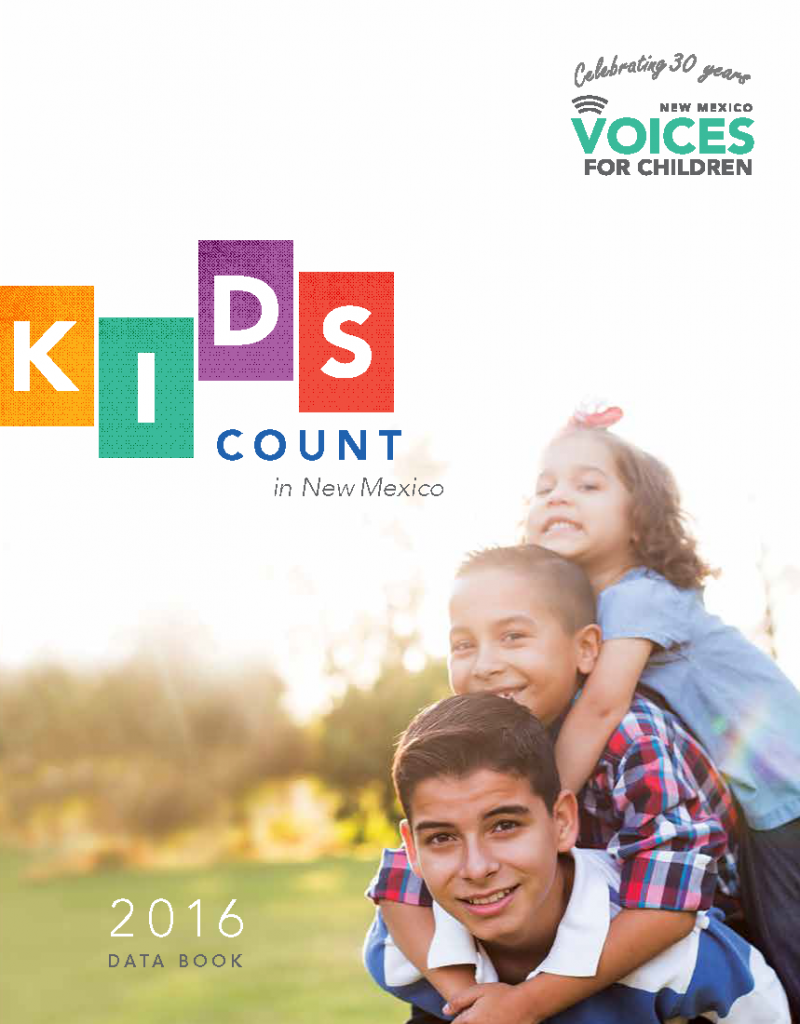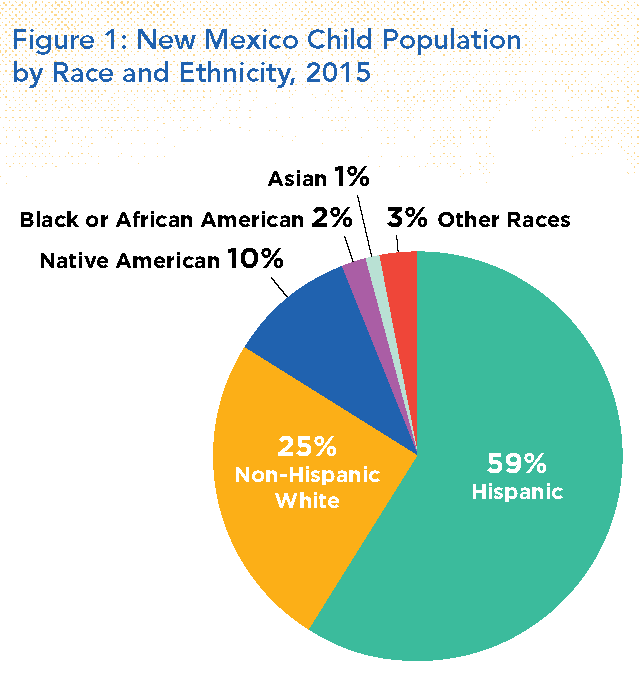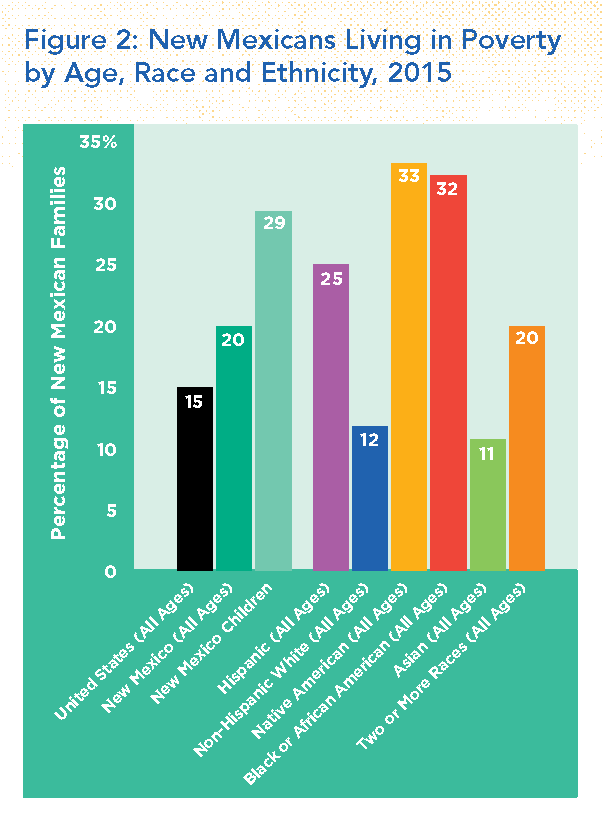Download the full report (Jan. 2017; 72 pages; pdf)
Link to the press release
Find more data for New Mexico and the nation on the KIDS COUNT Data Center
Introduction: Investing in Tomorrow Means Starting Today

All children, regardless of where they live, how much money their parents make, or the color of their skin, should have the best possible opportunities to reach their full potential. And if our state is to prosper, we need to make sure all children can develop intellectually, socially and emotionally.
When children have the opportunities they need to achieve their full potential, we all benefit as they become the doctors, teachers, artists, inventors, and entrepreneurs of tomorrow.
Brain science research tells us that the foundations for lifelong success are built early—in the first few years of life. We also know that adverse childhood experiences such as poverty, hunger, homelessness, and abuse weaken those foundations. Investing in our young children is good stewardship of our current and future resources as these investments have been shown to save money down the line while improving outcomes in the short and long terms. And while New Mexico has made strides in increasing investments in the services proven to help kids build strong foundations, we fall short of meeting the need. Unfortunately, the current budget situation in New Mexico is bad and may not improve for the foreseeable future.
But failing to make these investments in our young children will hurt our state and our economy in the long run. It means missing out on the opportunity to prevent problems now that will only become more costly down the road. New Mexicans understand and support the importance of these investments so in this document we present data to give more context on their importance. This data book tells the story of child well-being in New Mexico. It shows us where we stand, where we’re doing better, and where we need to improve. It serves as a tool and a resource for policy-makers, journalists, advocates, and other stakeholders to ensure kids’ needs are taken into account when decisions that impact them are being made. We invite readers to join us in harnessing the power of data in the fight to improve opportunities for New Mexico’s kids and families.
New Mexico’s KIDS COUNT Story
Each year, the Annie E. Casey Foundation’s national KIDS COUNT program ranks the 50 states in terms of child well-being.States are measured on 16 indicators organized into four domains: economic well-being, education, health, and family and community. In 1995, New Mexico was ranked 40th among the states for child well-being—the best our state has fared. By 2009, we had dropped to 43rd. In 2013, for the first time ever, we were ranked last in the nation for child well-being. Every year since then, including this year, New Mexico has ranked 49th among the states on overall child well-being. This report shines a light on our rankings indicator by indicator, shows how the data in each area have changed over time, takes a look at how counties, tribal areas, school districts, and racial and ethnic groups fare in the measures, and recommends some proven steps that we can take to improve the future for our kids and our state.
Investing in Children
Too often and for too long, New Mexico’s children have finished as runners-up in the race to be a high priority in policy decisions. We cannot invest in our children unless we have the funding to do so. A strong economy is more likely to produce the revenue we need, but New Mexico’s economy has still not recovered from the Great Recession. For too long, New Mexico has tried to pursue prosperity by offering tax cuts in hope that something good will happen. Clearly this approach has failed. Growth takes investment, which is why you can’t tax-cut your way to broad-based prosperity and good-paying jobs. Our children cannot afford to wait for the promised spoils of tax-cut economics to trickle down to them. New Mexico’s children—the state’s future workforce and leaders—are in crisis now. We must put kids first in policy decisions.
Children’s chances of being healthy, doing well in school, and growing up to be productive and contributing members of society are tied to their experiences in the early years. Good and nurturing experiences lead to good foundations for success. Sustained bad experiences detract from it. And in New Mexico, too many children suffer from too much of the later and not enough of the former. They don’t always have enough to eat, too often live in poverty, and many don’t benefit from high-quality early childhood care and education services.
Evidence suggests that poverty and low socioeconomic status are linked to poor health and educational outcomes and may have particularly long-lasting and powerful effects on children. Damage from bad conditions can begin even before birth and continue through the school years and into adulthood. By the same measure, positive child development is linked to improved health and education outcomes, and it is key to successful community and economic development. Knowing this, we cannot afford to allow nearly a third of our children to face such adversity and possibly fail to meet their full potential. Their futures and ours depend too much upon it.
Luckily, we know what works. Early childhood programs like home visiting, child care assistance, and pre-kindergarten lead to improved child well-being and are linked to significant long-term improvements for children and cost savings for states. So first and foremost, we must invest more in these early childhood programs now. Each year that we don’t invest means another year we’ve failed to prevent the problems that will arise from kids entering school unprepared to learn.
We also need to sufficiently fund K-12 education and support community schools and school-based health centers, particularly in low-resource communities. We need to make college affordable—not just in the future but now—so today’s parents and parents-to-be can gain the education and skills they need to get jobs that pay family-sustaining wages. And we need to particularly target children in those groups that have largely been left behind—children from low-income families and diverse racial and ethnic groups.
Investing in Equity
Laying the foundation for a prosperous future for our state requires us to ensure that we adequately prepare all of our children to become thriving, contributing members of our communities. In order to do this, we have to acknowledge that too often, children of color face higher hurdles to success, hurdles that are products of generations of policy choices. Equality of opportunity is not something that just happens:
it is a product of systems, policies, and programs that work together to create an atmosphere and foundation for all people to have an equal chance to participate and strive for success in society.
 In New Mexico, children of color face serious challenges at much greater rates than do many of their peers. They tend to have worse outcomes in economic well-being, education, and health, and in fact, racial and ethnic disparities exist in nearly every indicator of child well-being. Children of color are more likely to live in poverty and in high-poverty areas and are less likely to have access to health insurance and high-quality early educational opportunities.
In New Mexico, children of color face serious challenges at much greater rates than do many of their peers. They tend to have worse outcomes in economic well-being, education, and health, and in fact, racial and ethnic disparities exist in nearly every indicator of child well-being. Children of color are more likely to live in poverty and in high-poverty areas and are less likely to have access to health insurance and high-quality early educational opportunities.
Racial and ethnic disparities are of a particular concern in New Mexico because 75 percent of New Mexico’s children are children of color (see Figure 1). When disparities are evident among such a big portion of the population, the economic and social price of letting any group fall behind is high and—as demographics become increasingly more diverse—will only continue to grow. We need to pay particular attention to the systems—such as education, foster care, and juvenile justice—that fail these children. We must ensure, for example, that the least-experienced teachers are not all deployed to the schools with the most minority children, as is often the case. We need to determine why minority kids are placed in foster care more often than are white children who come from similar situations. And why minority kids are more often suspended from school, and treated more harshly within the criminal justice system, than white children who commit the same infractions. Preventing these disparities will improve how these systems work for all kids and it will improve outcomes for all of our communities.
In order to better understand and address racial and ethnic inequity, we need to collect and analyze racial and ethnic data and use it to inform policies and decision making. In order to ensure we’re receiving the greatest return on our investments, we must implement and continue to invest in proven, evidence-based programs that are inclusive of and focused on improving outcomes for children of color.
Investing in Families
A child’s well-being is strongly tied to his or her family’s stability and resources. Therefore these data show that, in addition to championing policies that invest in New Mexico’s kids, we must also promote strategies that strengthen New Mexico parents and families. Though life can be hectic for all families, low-income families often live on the edge of financial crisis. A sick child can mean lost work and wages for low-income parents. Living in substandard housing or high-poverty neighborhoods can put them and their children at environmental, health, and safety risk. High-quality early care is out of reach on their limited wages, so their children may bounce from family, to friends, to unlicensed care centers so parents can work. A job loss or a major car repair can sink them into poverty, food insecurity, or even homelessness.
 New Mexico’s high poverty rate—more than 20 percent of New Mexicans live at or below the poverty level—is one of the state’s most challenging problems (see Figure 2). While most other states have recovered from the recession, New Mexico has not. Just as our state cannot thrive when so many of our families are struggling economically, children are more likely to face stressors and adverse childhood experiences that negatively affect their brain development, long-term health, and socio-emotional well-being when their parents struggle.
New Mexico’s high poverty rate—more than 20 percent of New Mexicans live at or below the poverty level—is one of the state’s most challenging problems (see Figure 2). While most other states have recovered from the recession, New Mexico has not. Just as our state cannot thrive when so many of our families are struggling economically, children are more likely to face stressors and adverse childhood experiences that negatively affect their brain development, long-term health, and socio-emotional well-being when their parents struggle.
However, there are common-sense solutions to our economic problems and to the crisis that our kids and families are facing. In order to give New Mexico families and kids more opportunities to succeed, we must bring together programs for children and adults and take a deliberate and coordinated two-generational approach. All programs that seek to improve child outcomes should be coordinated with improvements in services that address the needs of parents. This two-generational approach is critical.
Programs like child care assistance, for example, provide direct benefits to children by ensuring they are in safe places to learn, grow, and be nurtured, while also offering low-income parents an affordable option for quality child care while they work. However, our child care assistance program is not well aligned with other programs that help parents go to school or get job training. Without this key bridge between programs, parents are less likely to be able to improve their long-term situation for their kids and families. Tax credits for low-income parents such as the Earned Income Tax Credit and New Mexico’s Working Families Tax Credit boost the incomes of working families to help them afford child care, transportation, housing and food. These credits are proven two-generational solutions that reward work and lift tens of thousands of New Mexico kids and families out of poverty each year. New Mexico should increase the value of its Working Families Tax Credit. New Mexico should also require large employers—particularly those that receive tax breaks—to offer their employees paid family, maternity, and sick leave as well as family-friendly scheduling so working parents can take care of newborns and sick children without the threat of losing employment and a secure source of income for their families.
Conclusion
In the full report, you’ll find more information on how New Mexico’s children and families fare in the 16 KIDS COUNT indicators. In tracking outcomes, we show differences across races, ethnicities, and counties, note some encouraging signs as well as outcomes that continue to be discouraging. We encourage you to use this data to help advocate for better outcomes for our state. All children should have access to opportunities and resources they need to reach their full potential. By investing in New Mexico’s kids and families, we can make our communities, our economy, and our state stronger. We’re all in this together, and investing in New Mexico kids is not just the right and the moral thing to do—it is also the smartest course of action to guarantee our state’s future success.
Figure 1 Source: U.S. Census Bureau, Population Division, 2015; aside from Hispanic, all races are non-Hispanic.
Figure 2 Source: U.S. Census Bureau, American Community Survey, 2015, Table S1701.
KIDS COUNT is a program of the Annie E. Casey Foundation.
